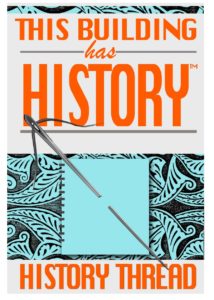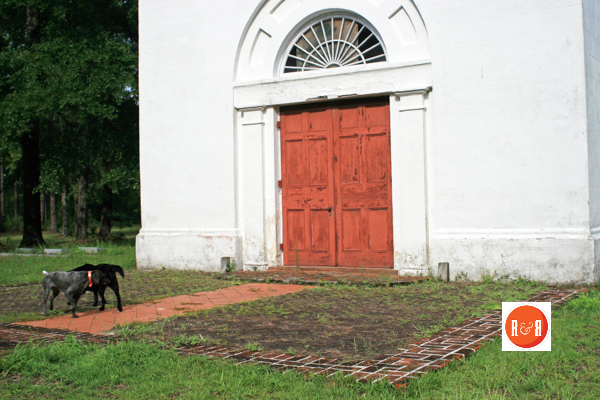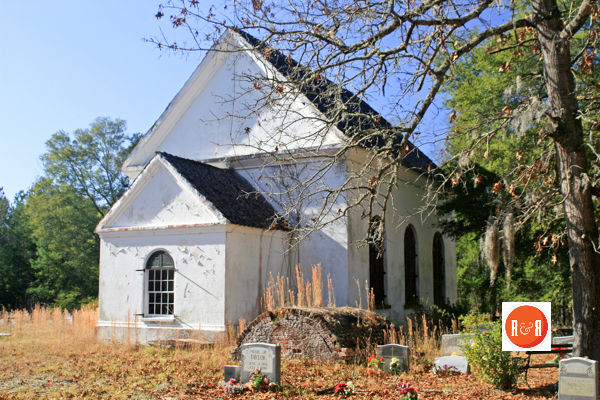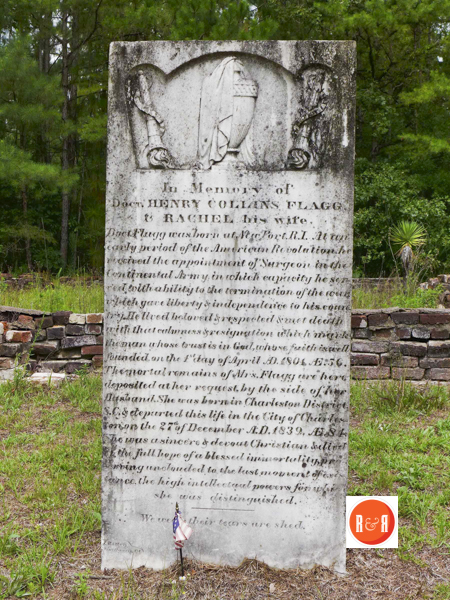1513 Cainhoy Road
“A South Carolina’s site having a strong connection to the turbulence of Southern reconstruction.”
City Directories and History: (St. Thomas & St. Dennis Parish Episcopal Church; Brick Church) White Church, or St. Thomas & St. Dennis Parish Episcopal Church, was constructed in 1819 and occupies the site of the older parish church of St. Thomas, which was built about 1706 but which burned in 1815. During the Reconstruction period, the church was the scene of the 1876 “Cainhoy Massacre,” a serious riot between  whites and blacks which developed when some white men from Charleston journeyed to Cainhoy to attend a Negro Republican meeting. The blacks fired upon the white men with guns they had hidden in a vault at St. Thomas churchyard. The church, charming in its simplicity of design, is a uniquely beautiful example of a small, rural parish church of the early 1800s. The church, with its Classical Revival or late Federal features, is made of stucco over brick with a medium gable roof made of tile. A high-arched doorway with a fanlight capped by a five-panel arch is set between pilasters. The side facades are identical. A balcony above the inside door was added about 1858. In 1937 the church was restored by . An unusual and distinctive auxiliary building is the vestry, with hipped roof on one end and chimney on the other, giving the appearance of a half-completed building. A cemetery dating from 1782 is included in the nomination. Listed in the National Register September 22, 1977. [Courtesy of the SC Dept. of Archives and History]
whites and blacks which developed when some white men from Charleston journeyed to Cainhoy to attend a Negro Republican meeting. The blacks fired upon the white men with guns they had hidden in a vault at St. Thomas churchyard. The church, charming in its simplicity of design, is a uniquely beautiful example of a small, rural parish church of the early 1800s. The church, with its Classical Revival or late Federal features, is made of stucco over brick with a medium gable roof made of tile. A high-arched doorway with a fanlight capped by a five-panel arch is set between pilasters. The side facades are identical. A balcony above the inside door was added about 1858. In 1937 the church was restored by . An unusual and distinctive auxiliary building is the vestry, with hipped roof on one end and chimney on the other, giving the appearance of a half-completed building. A cemetery dating from 1782 is included in the nomination. Listed in the National Register September 22, 1977. [Courtesy of the SC Dept. of Archives and History]
In 1763 St. Thomas merged with the nearby St. Denis French Huguenots and has since been known as St. Thomas and St. Denis Parish……Parish in 1731 “for the education and maintenance of the poor children of the parish and for no other purpose whatsoever.” This fund is still held by the Diocese of South Carolina, and its proceeds used for educational purposes. The original parish church burned, and the present picturesque little building with tile roof was built in 1815. St. Thomas and St. Denis fell into disrepair and disuse following the Cainhoy riot in 1876. In 1937 Bishop Albert S. Thomas interested Harry F. Guggenheim, New York industrialist and sportsman, in helping restore the fine little brick and stuccoed church. Mr. Guggenheim owned large acreage in the area and named his holdings Cainhoy, the name now held by his racing stables and under which his horses run. Occasional services are held at this historic church, surrounded by its parish graveyard in which are found families widely known in Carolina history
(Information from: Names in South Carolina by C.H. Neuffer, Published by the S.C. Dept. of English, USC)
Stay Connected
Explore history, houses, and stories across S.C. Your membership provides you with updates on regional topics, information on historic research, preservation, and monthly feature articles. But remember R&R wants to hear from you and assist in preserving your own family genealogy and memorabilia.
Visit the Southern Queries – Forum to receive assistance in answering questions, discuss genealogy, and enjoy exploring preservation topics with other members. Also listed are several history and genealogical researchers for hire.
User comments welcome — post at the bottom of this page.
Please enjoy this structure and all those listed in Roots and Recall. But remember each is private property. So view them from a distance or from a public area such as the sidewalk or public road.
Do you have information to share and preserve? Family, school, church, or other older photos and stories are welcome. Send them digitally through the “Share Your Story” link, so they too might be posted on Roots and Recall.
Thanks!
IMAGE GALLERY via photographer Bill Segars – 2006
GRAVE YARD GALLERY – Photo contributed to R&R by Gazie Nagle @ www.fineartbygazie.com















